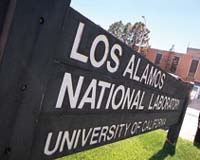 |
Washington DC (SPX) Nov 09, 2010 Whenever two pieces of metal at different voltages are brought near each other, as when an appliance is plugged into a live socket, there is a chance there will be an arc between them. Most of the arcs people see are a breakdown of the gas between the metal surfaces, but this type of breakdown can also occur in a vacuum. This vacuum breakdown, which until recently has not been well understood, has implications for applications from particle accelerators to fusion reactors. As part of an effort to understand the maximum accelerating field in particle accelerators, scientists at Argonne National Laboratory have been modeling the processes involved in vacuum breakdown. Now, a new model of this phenomenon is beginning to reveal what is happening in these arcs, and scientists are studying a number of new phenomena associated with them. In this new model, the breakdown arc is triggered by the electric field in the vacuum gap literally tearing the metal apart. (The same force that causes "static cling" can be very powerful for high electric fields, particularly at tiny corners, and in cracks where the fields are intensified by the local geometry of the surface.) After the metal is torn apart, the fragments should become ionized and form microscopic plasmas that are very dense and cold (for a plasma). Because of the high densities in these plasmas, the surface fields inside the arc quickly become even stronger than they were at breakdown. The arc becomes very damaging to the metal surface over a comparatively large area, eventually leaving a pit that should be visible to the naked eye. While this model seems to be internally consistent, researchers want to use it to produce predictions that can be verified experimentally. Current research is using molecular dynamics to show what happens at the atomic level when the material is torn apart, plasma modeling codes to show how the plasma initially forms and what its properties are, and electrohydrodynamics to show how the surface of the arc pit is affected. While current results seem generally consistent with existing experimental measurements, more precise tests are being developed. In principle, a better understanding of the precise causes of electrical breakdown should suggest solutions that are relevant to fusion reactors and space communications, among other things.
Share This Article With Planet Earth
Related Links American Physical Society Powering The World in the 21st Century at Energy-Daily.com
 Scientists Produce Transparent, Light-Harvesting Material
Scientists Produce Transparent, Light-Harvesting MaterialLos Alamos NM (SPX) Nov 08, 2010 Scientists at the U.S. Department of Energy's Los Alamos National Laboratory and Brookhaven National Laboratory have fabricated transparent thin films capable of absorbing light and generating electric charge over a relatively large area. The material, described in the journal Chemistry of Materials, could be used in development of transparent solar panels. "Potentially, with future ... read more |
|
| The content herein, unless otherwise known to be public domain, are Copyright 1995-2010 - SpaceDaily. AFP and UPI Wire Stories are copyright Agence France-Presse and United Press International. ESA Portal Reports are copyright European Space Agency. All NASA sourced material is public domain. Additional copyrights may apply in whole or part to other bona fide parties. Advertising does not imply endorsement,agreement or approval of any opinions, statements or information provided by SpaceDaily on any Web page published or hosted by SpaceDaily. Privacy Statement |